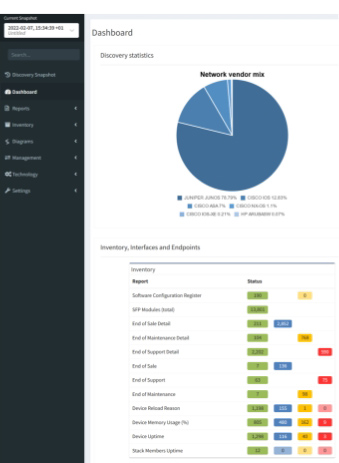

Enterprise networking professionals understand that their networks are not going to get less complex. The complexity isn’t going away, the business is only getting more demanding… good thing network engineers love wicked problem-solving, right? We’ve already covered all the demands placed on modern enterprise networks, but understanding the problem is half the job. We have to look at realistic ways to meet the challenge. A tempting solution is an oft-promised single pane of glass (SPoG) solution. Clean, simple dashboards that show you everything you need to know about your network, integrate cleanly with your existing tools, in a user-friendly and understandable interface. A dream, right?
That’s the frustrating truth. There’s a huge incongruency between the expectation and reality of SPoG tools, and their utility in network management. Simply put, in an attempt to marry disparate network data and gain a deeper understanding of your network behavior, using them can have the opposite effect, keeping your understanding of the network limited - like a match in a forest, lighting some of the way, the utility burns out quickly and leaves your understanding of your environment shallow (or potentially burns down everything around you with a wrong move).
Since we've really been on this metaphor of the enterprise network as a living ecosystem, let's continue. A limited SPoG tool reminds me of Bolton Strid - if you've never heard of it, it's a seemingly idyllic six-foot stretch of river in Yorkshire. Appearing shallow to passersby, it is, in reality, incredibly deep and deadly should you fall in, and its calm surface hides swirling, beating water hammering the sides of dangerous cave formations. Like with a stroll in the woods, when it comes to your network, knowledge is power, and preparation is key.
Let’s look at why.

Having an overview of your network is certainly useful, but simply papering over complexity to make network management seem simple will have consequences.
That's not to say some abstraction is not useful. Automated network assurance places emphasis on interpreting and normalizing network data to make it consumable. But there's a difference between making use of consumable, accessible network data to introduce, for example, self-service processes, or eliminate bottlenecks in cross-team workflows, and letting a limited scope of visibility become your only view of the network because the limitations haven't had consequences - yet.
Common limitations that will hinder how useful your SPoG solution is include:
This can create the exact opposite of what you trying to achieve; more information siloes, more team friction, and more network vulnerability.
The IP Fabric platform offers the most comprehensive network data about your entire network estate, regardless of vendor or domain. It's also easy to plug this end-to-end understanding into whatever tools you need via REST API. The result is that you can easily surface information needed by different SMEs throughout your entire network ecosystem. And it's normalized, structured, and vendor-neutral. And therefore, useful.
Frankly, no product can “do it all” for your network (and if they claim that, prepare for disappointment). There will be necessary limitations.
When a network issue falls beyond the scope of the tool you’re relying on, you won’t have the context necessary to solve the issue efficiently. More problematically, when you isolate the issue, wading out of the comfy confines of your nice little network abstraction may reveal gaps in your network knowledge, if you’ve been hands-off with other domains of your network for too long.
You might have to ask yourself an uncomfortable question if you’ve been coasting with a tool that abstracts parts of your network but masks its vast and messy nature. Do you really know your network? Do you know it end to end?
Relying on single-pane-of-glass tools with a limited view of your network will translate to you having a limited understanding of the network. The daily bread and butter of network engineers – configuration changes, incident resolution, expanding the network – all have effects throughout your interconnected network environment.
We’ve characterized the modern enterprise network as a living being before. Just like a living being, our environmental changes can have knock-on effects we won’t see with tunnel vision. Our perspective of the network must be holistic for it to thrive.

Automated network assurance goes beyond checking and validating the operational state of one device. Understanding the outcome of change on the whole network is essential. Understanding the full blast radius of network incidents, and observing the ripple effects of network change... this is what you’re missing when you rely on a fish tank to tell you something about the ocean tides.
Single pane of glass tools are used in enterprise IT systems to get a unified view of network operations. However, despite their convenience, they have limitations that can impede their effectiveness in modern, complex network environments. Their limitations may give network operators a false sense of security that can have consequences on your entire network ecosystem.
Rather than trying to find the one - that magic tool that's going to solve all your problems - the modern network team should focus on building a trackable and comprehensive foundation of network knowledge that be leveraged for different use cases in a stable and trustworthy way. This can help IT teams make data-driven decisions without the fear of network unknowns. Automated network assurance is a clear answer to this need.

Enterprise networking professionals understand that their networks are not going to get less complex. The complexity isn’t going away, the business is only getting more demanding… good thing network engineers love wicked problem-solving, right? We’ve already covered all the demands placed on modern enterprise networks, but understanding the problem is half the job. We have to look at realistic ways to meet the challenge. A tempting solution is an oft-promised single pane of glass (SPoG) solution. Clean, simple dashboards that show you everything you need to know about your network, integrate cleanly with your existing tools, in a user-friendly and understandable interface. A dream, right?
That’s the frustrating truth. There’s a huge incongruency between the expectation and reality of SPoG tools, and their utility in network management. Simply put, in an attempt to marry disparate network data and gain a deeper understanding of your network behavior, using them can have the opposite effect, keeping your understanding of the network limited - like a match in a forest, lighting some of the way, the utility burns out quickly and leaves your understanding of your environment shallow (or potentially burns down everything around you with a wrong move).
Since we've really been on this metaphor of the enterprise network as a living ecosystem, let's continue. A limited SPoG tool reminds me of Bolton Strid - if you've never heard of it, it's a seemingly idyllic six-foot stretch of river in Yorkshire. Appearing shallow to passersby, it is, in reality, incredibly deep and deadly should you fall in, and its calm surface hides swirling, beating water hammering the sides of dangerous cave formations. Like with a stroll in the woods, when it comes to your network, knowledge is power, and preparation is key.
Let’s look at why.

Having an overview of your network is certainly useful, but simply papering over complexity to make network management seem simple will have consequences.
That's not to say some abstraction is not useful. Automated network assurance places emphasis on interpreting and normalizing network data to make it consumable. But there's a difference between making use of consumable, accessible network data to introduce, for example, self-service processes, or eliminate bottlenecks in cross-team workflows, and letting a limited scope of visibility become your only view of the network because the limitations haven't had consequences - yet.
Common limitations that will hinder how useful your SPoG solution is include:
This can create the exact opposite of what you trying to achieve; more information siloes, more team friction, and more network vulnerability.
The IP Fabric platform offers the most comprehensive network data about your entire network estate, regardless of vendor or domain. It's also easy to plug this end-to-end understanding into whatever tools you need via REST API. The result is that you can easily surface information needed by different SMEs throughout your entire network ecosystem. And it's normalized, structured, and vendor-neutral. And therefore, useful.
Frankly, no product can “do it all” for your network (and if they claim that, prepare for disappointment). There will be necessary limitations.
When a network issue falls beyond the scope of the tool you’re relying on, you won’t have the context necessary to solve the issue efficiently. More problematically, when you isolate the issue, wading out of the comfy confines of your nice little network abstraction may reveal gaps in your network knowledge, if you’ve been hands-off with other domains of your network for too long.
You might have to ask yourself an uncomfortable question if you’ve been coasting with a tool that abstracts parts of your network but masks its vast and messy nature. Do you really know your network? Do you know it end to end?
Relying on single-pane-of-glass tools with a limited view of your network will translate to you having a limited understanding of the network. The daily bread and butter of network engineers – configuration changes, incident resolution, expanding the network – all have effects throughout your interconnected network environment.
We’ve characterized the modern enterprise network as a living being before. Just like a living being, our environmental changes can have knock-on effects we won’t see with tunnel vision. Our perspective of the network must be holistic for it to thrive.

Automated network assurance goes beyond checking and validating the operational state of one device. Understanding the outcome of change on the whole network is essential. Understanding the full blast radius of network incidents, and observing the ripple effects of network change... this is what you’re missing when you rely on a fish tank to tell you something about the ocean tides.
Single pane of glass tools are used in enterprise IT systems to get a unified view of network operations. However, despite their convenience, they have limitations that can impede their effectiveness in modern, complex network environments. Their limitations may give network operators a false sense of security that can have consequences on your entire network ecosystem.
Rather than trying to find the one - that magic tool that's going to solve all your problems - the modern network team should focus on building a trackable and comprehensive foundation of network knowledge that be leveraged for different use cases in a stable and trustworthy way. This can help IT teams make data-driven decisions without the fear of network unknowns. Automated network assurance is a clear answer to this need.





